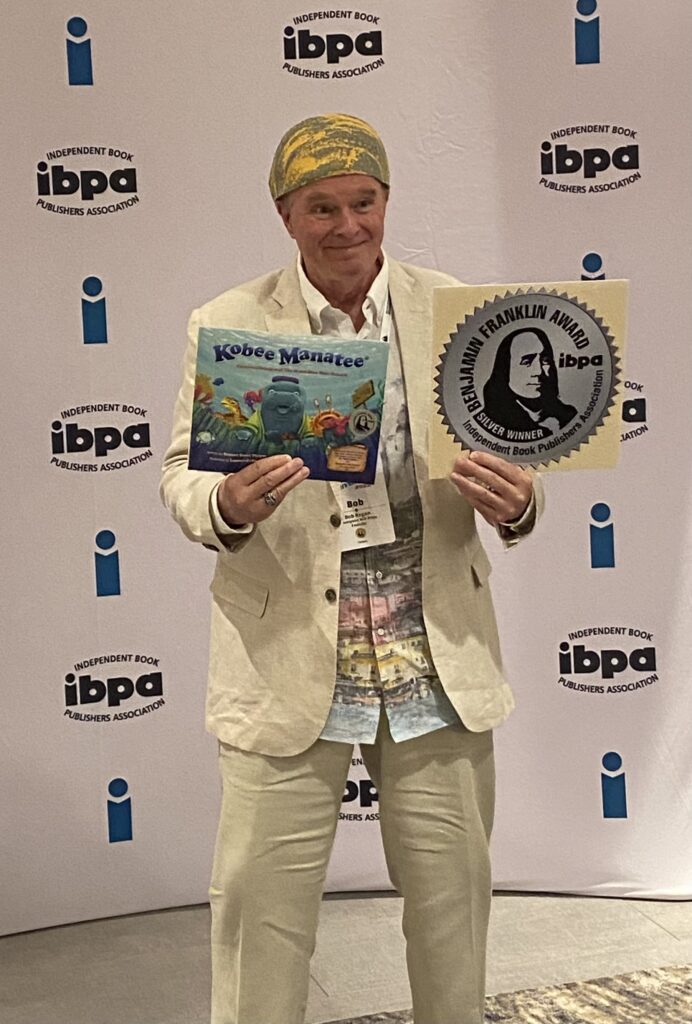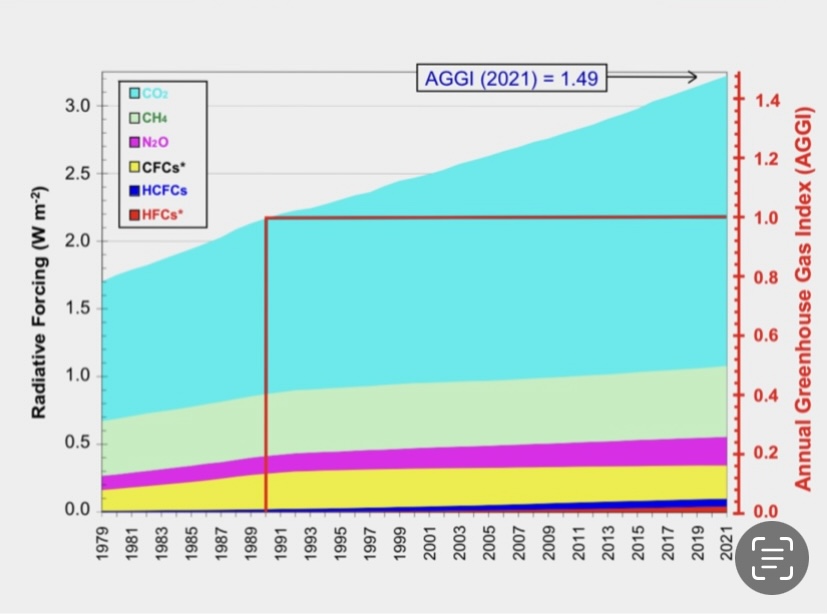NOAA Maps Explosion of Greenhouse Gas Pollution … Seized 49% More Heat in 2021 versus 1990!
Carbon Dioxide CO2 = Light blue
Methane CH4 = Light Green
Nitrous Oxide N2O = Pink
Chlorofluorocarbons (Aerosol sprays) CFCs = Yellow
Alternatives to Chlorofluorocarbons HCFCs = Dark Blue
Hydrofluorocarbons (Cooling & Refrigeration) HFCs = Red
Greetings! I’d like to continue talking about the sobering effects of climate change with a new report from the National Oceanic Atmospheric Administration [NOAA]. NOAA scientists explain, “Greenhouse gas pollution caused by human activities trapped 49% more heat in the atmosphere in 2021 than they did in 1990.”
The graph above is from NOAA’s Annual Greenhouse Gas Index [AGGI]. The AGGI “tracks increases in the warming influence of human emissions of heat-trapping gases, including carbon dioxide, methane, nitrous oxide, chlorofluorocarbons, and 16 other chemicals. The AGGI converts the complex scientific computations of how much extra heat these gases capture into a single number that can easily be compared to previous years and tracks the rate of change.”
The AGGI is indexed to 1990 (as shown in red box), the year the first IPCC Scientific Assessment of Climate Change was published. IPCC is Intergovernmental Panel on Climate Change.
Ariel Stein, acting Director of NOAA’s Global Monitoring Laboratory (GML) said, “The AGGI tells us the rate at which we are driving global warming. Our measurements show the primary gases responsible for climate change continue rising rapidly, even as the damage caused by climate change becomes more and more clear. The scientific conclusion that humans are responsible for their increase is irrefutable.”
Stein continues, “In 2021, the AGGI reached a value of 1.49, which means that human-emitted greenhouse gases trapped 49% more heat in the atmosphere than in 1990. Because it is based primarily on highly accurate measurements of greenhouse gases in air samples collected around the globe, the result contains little uncertainty.”
CO2 is Biggest Offender!
NOAA explains, “Carbon dioxide, or CO2, is by far the most abundant human-emitted greenhouse gas. Roughly 36 billion metric tons of CO2 are emitted each year by transportation, electrical generation, cement manufacturing, deforestation, agriculture, and many other practices. A substantial fraction of CO2 emitted today will persist in the atmosphere for more than 1,000 years. Not surprisingly, it is also the largest contributor to the AGGI in terms of both amount and rate of increase.”
Pieter Tans, GML Senior Scientist said, “CO2 is the main player because it stays in the atmosphere and oceans for thousands of years and it is by far the largest contributor to global warming. Eliminating CO2 pollution has to be front and center in any efforts to deal with climate change.”
Looking at the graph above, it’s obvious to see the rapid increase in CO2 as shown by its blue color.
Our Award-Winning Climate Change Title Brings Easy Effortless Reading with Kids!
Our award-winning fourth installment in the Kobee Manatee® Children’s Educational Picture Book series is an easy and effortless tool teaching kids about climate change. You can order it here: https://www.kobeemanatee.com/products/kobee-manatee-climate-change-and-the-great-blue-hole-hazard/

When you read this award-winning educational picture book to children, you’ll discover it’s a fun and fictional adventure loaded with weaved in facts on climate change and plastic pollution. This helps children learn about this serious subject in a fun and entertaining way. Here’s a brief synopsis …
Kobee Manatee, the protagonist and his seafaring pals, Tess the seahorse and Pablo the hermit crab swim from the Cayman Islands to Belize. Kobee wants to help his cousin Quinn clean up plastic litter at her new, all-veggie underwater bistro called Quinn’s Seagrass Café.
On their Caribbean journey they encounter harmful effects of climate change and plastic pollution. As if that wasn’t enough, several other unforeseen problems occur with a distressed loggerhead turtle, a giant Portuguese man-of-war, and a venomous scorpionfish. They’re all amazed when they discover the extraordinary Great Blue Hole. Then their adventure takes another crazy turn when Pablo plunges into its huge abyss!
Each page includes in-depth, scientific details on climate change and plastic pollution in our oceans with Dr. Tracy Fanara, Inspector Planet & NOAA Scientist. Tracy can be seen on The Weather Channel as a visiting expert and she’s also seen on their “Weird Earth” segments.
We have Fantastic Reviews on this New Release!
“A well-crafted, thoughtful, and well-illustrated addition to a noteworthy educational book series.” —Kirkus Reviews
“Robert Scott Thayer presents an important environmental message in an engaging story with wonderful characters. Anyone who loves the ocean and wants to help save it should read Kobee Manatee: Climate Change and The Great Blue Hole Hazard. I’m looking forward to the next Kobee Manatee adventure.” —Readers’ Favorite
For young readers who enjoy imaginative tales surrounding affable and heroic sea creatures, as well as parents and/or teachers looking for a way to introduce youngsters to the importance of marine conservation, Kobee Manatee® Climate Change and The Great Blue Hole Hazard offers a perfect blend. Highly recommended! – Chanticleer Book Reviews
Keep watching for more of my updates on climate change!
If you see any sick or injured manatees, please call the Florida Fish and Wildlife Conservation Commission at: 1-888-404-3922 (FWCC). They are the folks who are responsible for rescuing us in Florida.
Here’s the Save the Manatee Club link to learn more about us manatees …
Here’s a cool link for you to learn more about how we’re rescued and brought into rehabilitation …
~ Robert Scott Thayer
Related Posts
